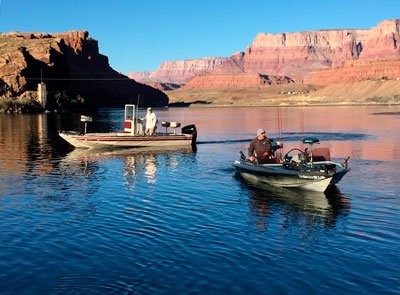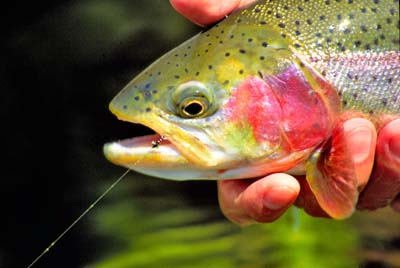By Terry Clapp
First off, this part of Trout Heaven is about as hard to access as it is to get through the Pearly Gates. I’m just saying for the DIY person it’s as remote in as many ways as it is beautiful and unique. It’s a year-round trout fishing stream like no other. If you like to hike, rappel and trout fish in nature’s most beautiful sandstone landscapes, you have arrived. However, if you are like me, you either drive up to the Lee's Ferry boat launch area or hook up with one of many local outfitters.
Lee's Ferry
Lee's Ferry is below The Glenn Canyon Dam on The Colorado River with Page, AZ being the nearest town. The dam controls the flow of very cold water coming from the bottom of Lake Powell. This discharge of cold water has changed a warm water river into an aquatic insect producing paradise. Hatches here change depending on how far below the dam you fish. This nutrient rich aquatic environment makes up the first fifteen miles or so of the tailwater from the dam to the Paria Riffle at Lee's Ferry. The river is famous for big, healthy, beautiful rainbows.
But also, this first section of the river has the most restrictions. These restrictions include no bait, barbless hooks and artificial fly or lure only. Daily limit here is two rainbows any size (but catch and release is highly recommended). Trout caught here are immediately released or killed and retained as a part of the daily limit. An Arizona Fishing License is required on all parts of the river. The Arizona Non-resident Fishing License is $55. You can park, camp and launch a power boat from Lee's Ferry. If you bring your own boat, be aware of the water flow as it changes often. Lower, very clear water can mean possible rock damage to your motor or boat. Boating this river can be dangerous any time, especially during your first visit. A word to the wise; play it safe, stay in the main channel.
Fly Fishing
Fly fishing the tail water from the dam down river is not as fabulous as it was years ago, but it is still great. If you fly fish this section of river, it is best done below the surface. These waters are mostly nymph fishing. If conditions are right, you may wish to try dry flies. The most important insects here are blood and cream colored midges. There are also mayflies, stoneflies, and caddisflies. The blue-winged olive mayfly appears first and is the most abundant. Hatches start in late March and peak in late May. The hatch begins again in September, ending in early November. The spawn is late fall to early November. The spawn is a wonderful time to sight fish for the fish you want. Just cast to the fish you have your eye on.
 Down River Rule Changes
Down River Rule Changes
From the Paria Riffle at the Lee's Ferry area to the Navajo Bridge, the limit of rainbow trout is six per day. There is no limit on other sport fish species, including trout species. Be advised that once you go down river from Lee's Ferry, there are no take-out points. If you have any problems with your boat, it may be extremely difficult to get back to Lee's Ferry. Most people use drift boats and some use jet boats going up river from Lee's Ferry and floating back from the dam area. You can fish from the bank as well through this area once accessed. Good fishing for rainbows is a given, but it still takes some effort and fishing expertise to catch them at times.
Hiking and Fishing
From Navajo Bridge to Separation Canyon, there is no limit on any sportfish species. Given that, a fun but vigorous way to get at that wide-open fishing opportunity is to hike down Jackass Creek (Wash). It is a hike like no others. Rock obstacles and drop-offs abound. In my opinion, there is no such thing as an easy hike down to the Colorado River. The 2.4-mile hike to the river seems like double that to me! This is a nice overnight hiking and fishing experience. There is a parking area where US 89 crosses the canyon. Parking is on the east side of the Colorado, just after milepost 532. The best way to get a feel for this hike is to search for Jackass Creek, Arizona or trails into the Colorado River of The Grand Canyon.
Rocks rule Jackass Creek. There are several five to twenty-foot drops. The Navajo Fishermen have left ropes on most drops to help hikers pass through. There is one big challenge in a short narrow section of the wash where there is one thirty-foot drop to a pool in the wash below. There will be ropes available to help you descend down. Water is available only in the river and pools in the wash. Plan accordingly for your water needs. If it is raining, it is not advisable to hike Jackass Creek. Near the river you will see a sign, “Welcome to Grand Canyon National Park.” California Condors are a common sight as you will be near their home in the nearby Vermilion Cliffs. Fishing on the river here is very good. Remember, there are no camping accommodations other than the welcome sign. A Navajo Hiking Permit is recommended.
 Cost
Cost
If you hike into the river to fish, then the appropriate Arizona Fishing License is needed. Motels in the area of Lee's Ferry to Page vary from season to season, with winter rates being the lowest at $80 to $100. Rates in the summer will run from over $100 to near $200. In any case, plan ahead because motel rooms are very limited near Lee's Ferry. Page offers more, but Lake Powell is a big-time summer attraction as is The North Rim of The Grand Canyon. Lee's Ferry is about three hours north of Flagstaff and a little over five hours north of Phoenix.
A good way to get a great overview of the river and how to fish it is to hire an outfitter. Cost for eight hours of fishing is about the same for most outfitters. The guide will provide boat, water and lunches for members of your group. The guide service will provide equipment to fish with if you wish. You may use your own equipment if you wish. Things of a personal nature like waders or other gear are best to bring. The cost for these guide services is $400 a day for one person, $500 for two people or $600 a day for three people. With three people, it may mean taking turns fishing at times while in the boat, but you will also be stopping off at sand bars for wade fishing as well. Fly fishing and spin cast fishing are the norm. Spinners with the colors of a rainbow usually work well for the spin fishing group.
There is a ton of good information about Lee's Ferry available online. Fly fishing on the Colorado, of course, gets the most attention. Glen Canyon National Recreation Area (https://www.nps.gov/glca/index.htm) lists information for the upper part of the Colorado River. Grand Canyon National Park has information on trailheads for canyon and washes leading hikers/fishermen down to the Colorado River. Tanner Wash, for example, is another hike-in opportunity. Planning far in advance can make Lee's Ferry fit most budgets. If you have to go a little over budget on this trip, it will be more than worth it as this part of the country is truly breathtaking. Enjoy!

